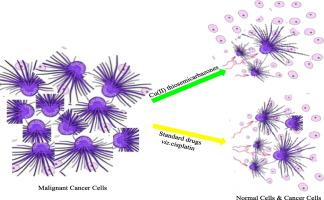Journal of Inorganic Biochemistry ( IF 3.8 ) Pub Date : 2020-06-11 , DOI: 10.1016/j.jinorgbio.2020.111134 Narendra Kumar Singh 1 , Anupa A Kumbhar 2 , Yuba Raj Pokharel 3 , Paras Nath Yadav 4

|
Being a structural and catalytic cofactor in a number of biological pathways, copper accumulates in tumors owing to selective permeability of the cancer cell membranes. Copper(II) ion forms the active centers in a large number of metalloproteins. The coordination of Schiff's base ligands to the metal ion results in the high extent of increase in anticancer activity. The copper(II) complexes can cleave DNA through oxidative and hydrolytic pathways, cell apoptosis via intrinsic reactive oxygen species (ROS) mediated mitochondrial pathway due to excessive production of ROS and hence, are found more active than Ni and Pt complexes. Flexible Cu(I/II) redox behavior helps the copper complexes to form more potent, clinically effective and less toxic copper based antiproliferative drugs of lower IC50 value and higher growth inhibitory activity. Copper(II) complexes of thiosemicarbazones of Isatin, Pyridine, Benzoyl pyridine, Diacetyl/Dimethyl glyoxal, Acetophenone/Acetoacetanalide, Thiazole/Pyrazole, Quinoline, Carboxybenzaldehyde, Cinnamaldehyde/Cuminaldehyde, Citronellal, Chromone, Pyridoxal, 8-Ethyl-2-hydroxytricyclo (7.3.1.02,7) tridecan-13-one, Acyl Diazines, Naphthalene, Proline, 5-Formyluracil, 2-Hydroxy-8-propyltricyclo (7.3.1.02,7) tridecan-13-one, 9-cis-Retinal, Curcumin, Helicin (Salicylaldehyde-β-D-glucoside), Thiophene carboxaldehyde, Salicylaldehyde, Iminodiacetate, and 3-Formyl-4-hydroxy benzenesulfonic acid have been found to exhibit more anticancer activity toward HCT116, MCF7, A549, U937, HeLa, HepG2, SGC-7901, A2780 cell lines than that of their corresponding thiosemicarbazones and standard topoisomerase-II inhibitors.
中文翻译:

硫代半脲酮的铜(II)配合物的抗癌效力。
作为许多生物途径中的结构和催化辅助因子,由于癌细胞膜的选择性渗透性,铜在肿瘤中积累。铜离子在大量金属蛋白中形成活性中心。席夫氏碱配体与金属离子的配位导致抗癌活性的高度提高。铜(II)络合物可通过氧化和水解的途径,细胞凋亡切割DNA经由介导的线粒体通路内在反应性氧物质(ROS)由于过度ROS的产生,并因此,发现除Ni和Pt络合物更活跃。灵活的Cu(I / II)氧化还原行为有助于铜络合物形成更有效,临床上有效且毒性较低的铜基抗增殖药,IC 50较低价值和更高的生长抑制活性。Isatin,吡啶,苯甲酰吡啶,二乙酰基/二甲基乙二醛,苯乙酮/乙酰乙酰氨基化物,噻唑/吡唑,喹啉,羧苯甲醛,肉桂醛/ Cuminaldehyde,香茅醛,苯甲酮,苯二酚,2-羟基三乙氧基的巯基半金属铜(II)配合物7.3.1.0 2,7)tridecan-13-one,酰基二嗪,萘,脯氨酸,5-甲酰尿嘧啶,2-羟基-8-丙基三环(7.3.1.0 2,7)tridecan-13-one,9- cis-视黄醛,姜黄素,Helicin(水杨醛-β-D-葡萄糖苷),噻吩羧醛,水杨醛,亚氨基二乙酸酯和3-甲酰基-4-羟基苯磺酸对HCT116,MCF7,A549,U937, HeLa,HepG2,SGC-7901,A2780细胞系比它们相应的硫代半脲和标准拓扑异构酶II抑制剂的细胞系要强。











































 京公网安备 11010802027423号
京公网安备 11010802027423号